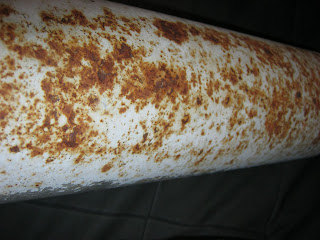Shortly after sunset
This photograph captured a glimpse of what I saw…
What was there to see…
Naked eye observation:
Venus was first to become visible, at about WNW. It was something like 15 to 20 minutes after the Sun had set behind some hills that Venus became visible in the West, very bright, slightly over the horizon (about a hand's width). No stars were visible at this time.
After some time a slightly dimmer Saturn appeared to the lower left of Venus.
This was followed after some more time by a Mercury (that was first noticed with an 8x21 binocular), to the left and higher than Venus. With the naked eye Mercury was barely noticeable.
The angular distance between Venus and Mercury was about twice (give or take) that between Venus and Jupiter, with Mercury being vertically above Jupiter (give or take).
Without my glasses I was not able to notice any of these three planets – not even Venus.
Observation with 8x21 binoculars:
All three planets were clearly visible in small 8x21 binoculars. But I spend little time with binoculars as I moved on to the telescope.
Observation with 76mm/700mm Optus refractor telescope:
The distance between Venus and Jupiter filled almost the field of view both with the CZJ H40mm eyepiece (about 1.5 degree FOV and about 17x mag) and with the LOMO Sym17mm eyepiece (about 1.4 degree FOV and 42x mag). So the apparent separation between Venus and Jupiter was about 1.3 degrees (give or take).
Both Venus and Jupiter were clearly discernible as discs at both at 42x with the LOMO Sym17mm, and at 70x with the Spindler Ortho10mm eyepiece – albeit small discs. Jupiter is about 45 arcseconds in diameter at the moment, and Venus about 10 arcseconds.
For Jupiter I thought I could discern horizontal stripes at 70x mag, but conditions were not good (my very small experience, cheap and not properly collimated telescope, Jupiter barely above the horizon and still much light from the Sun) – with that I would not say I saw the actual stripes of Jupiter.
I attempted to view Mercury in the telescope, but gave up after a short time as pointing the telescope (with its awful, awful, awful az-alt-mount) was very difficult for me.
The pointing of the telescope was made worse by the fact that I used the telescope without glasses (short eye relief of 8mm for the Spindler eyepiece), but had to put my glasses on to use my improvised finder (a simple tube in lieu of an real finder)… So either I need a finder system that – for me – works without glasses (that would rule out any "telrad" type of finder), or I need eyepieces that work with glasses. I'm not thrilled as I don't want to spend any money for this at this time.
Before packing up I tested the collimation on some stars, but couldn't get a proper focus. The collimation is still off, it seems… Will try to collimate the telescope with an artificial star.
A photo taken while the conjunction was visible, just to the left of the frame… ;-(
The problem with photography was that I set the camera's field of view while the Sun was still up, and forgot to adjust it once the conjunction was visible. Too many instrument (two cameras, a binocular and a telescope) and too little focus on the task. Oh well.
As it turns out I also took the wrong lens anyway. I took my 17mm-85mm telezoom, which of course has an high f-ratio of f/5.6 at 85mm. This means long exposure time and long streaks. What I should have taken instead was my 50mm prime focus lens (that was still in some package from my last move) with an f-ratio of f/1.8 – with this I could have used shorter exposure times at the fully opened aperture. The things I should have known since long – but have long forgotten, it seems.
Also, I probably should have switch to a higher ISO setting. I used ISO 100 (as I do for the daytime shots), but ISO 200 or maybe even ISO 400 would have been much more sensible…
An additional problem with photography was that I wanted the conjunction to be close to the castle (to mimic Thierry Legault's wonderful shot of the conjunction above Mont-Saint-Michel), but from the observation site I choose (with the help of Google Earth and a little bit of scouting by binocular) there was too much distance between the two – the conjunction further south, the castle further north. Next time I should choose a site a bit further north, but don't know if I can see the city as well from there…
Loose ends:
After I was packing up – it was cold and my muscle ache was no longer ignorable – I saw for a second a very bright thing, about NNW, maybe 30 or 40 degrees above the horizon. This was possibly a satellite flare I guess.













